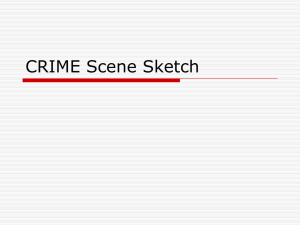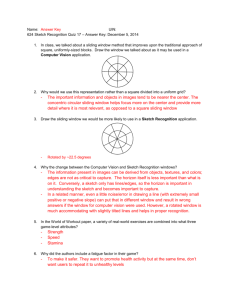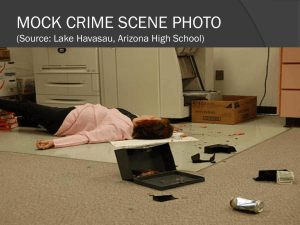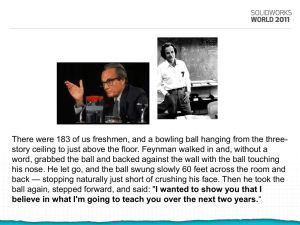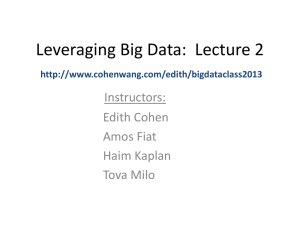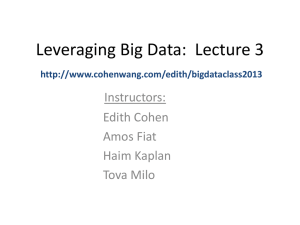Sketching - CSI: Coronado
advertisement
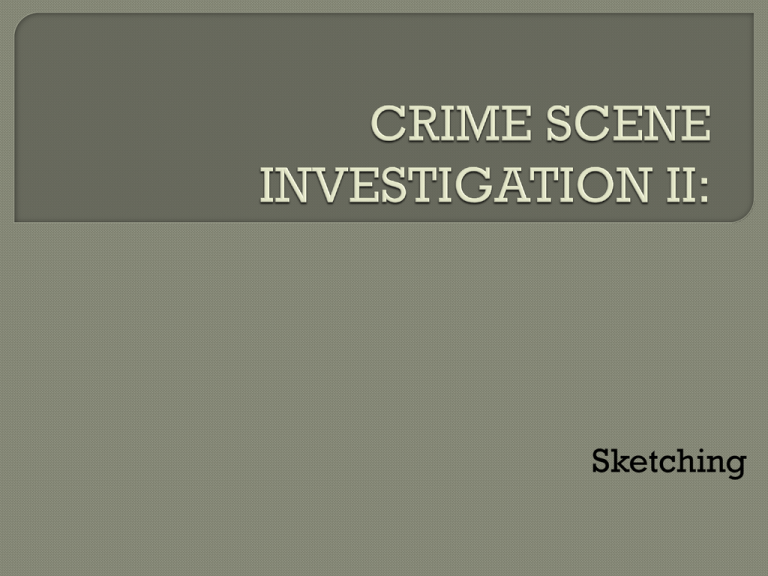
Sketching Securing the Scene Separating the Witnesses Scanning the Scene Seeing the Scene (photography) Sketching the Scene Searching for Evidence Securing and Collecting Evidence Present a clear “mind’s eye” picture of the crime scene Complement investigator’s notes and photos Show accurate location and relationships of the evidence items Refresh the memory of investigators Illustrate the testimony of witnesses Provide factual data for crime scene reconstructions Plan systematically for sketching: how many and what type of sketches will be needed to convey scene to attorneys, judges, and jury First show in rough form the overall layout of the scene: graph paper is useful in making this sketch Prepare a detailed sketch of each pertinent area with accurate measurements Prepare blowup sketches as necessary: use these for critical areas such as bloodstain patterns, bullet trajectories and areas containing large numbers of evidence items Show compass points on sketch: north arrow Make accurate measurements for all evidence items: each item requires measurements to at least two fixed points; label evidence using numbers Measure the dimensions and location of all furniture: label furniture using letters Measure the location of all windows and doors: include the direction of door opening Have 2 individuals verify all measurements Use equal accuracy for measurements for items on the same sketch: if more accuracy is required, make a separate blowup sketch Use fundamental methods for measurements: use metal tapes and walker wheels; use feet and inches unless in a metric measurement country Exception: when measuring bloodstains for bloodstain pattern reconstructions, use metric units Avoid common errors: • Make sure tape is straight and doesn’t sag • Don’t read numbers upside down (6 for 9) • Reading the wrong foot mark • Confusing the zero point on the tape General area sketch: • Illustrates the general area in which the crime scene occurs • Used for orientation of other sketches • It does not have measurements • Only approximates the relative size of various area Detailed sketch: • Contain measurements for all evidence item locations and other pertinent objects such as furniture • Not drawn to scale but proportions should be similar Blowup Sketch: • Allow for higher accuracy of measurements for blood spatter, bullet trajectories or other pattern evidence • Detailed sketches of small areas inside larger sketch Exploded View Sketch: • Shows the walls flat • Used to illustrate interrelationship of blood spatters, bullet holes, and trajectories Elevation Sketch: • Used to show slopes present in the scene • These are rough sketches to show the elevation perspective of a crime scene Not to Scale: • For report purposes only; not to be used in the courtroom • Not to scale • Label sketch “NOT TO SCALE” Drawn To Scale: • Scale: shows proportional size of objects in • • • • • relation to each other; actual measurements can be determined by the given scale Drawn in pencil first Drawing pens are used to draw over pencil lines Include legend—explains what the symbols actually are on the drawing or map Include title—what is the drawing of and where Include compass directions—which way is north, so all directions can be determined Computer Sketch: • Often used in the court room by attorneys to explain information to the jury Rectangular coordinates: • Easiest to use indoors where there are 4 walls in a rectangular format • Each item must have measurements to 2 walls that abut each other • Can be used outdoors where there are fixed areas with rectangular formats Triangulation : • Used indoors and outdoors • Advantage of this method is easy • • • • • to make measurements Requires a minimum of 2 people Uses 2 fixed reference points Measurements are made from the first point to the item(s) Measurements are then made from the second point to the item(s) This creates a triangle Secondary reference points : • An extension of either the rectangular coordinates method or the triangulation method • Area to be sketched is distant from the primary reference points • Secondary points can be established by measurement from the primary reference points Transecting baseline : • Requires laying out a metal measuring tape in a line between two fixed points • Measurements to each item are made at 90o to the measuring tape • The length along the baseline is also recorded, thus giving the required two measurements for each item Polar Coordinates: Devised of a two-dimensional system where each point is determined by a distance and angle from a center point

